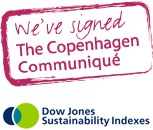Climate neutrality and beyond
 Globally, Pearson emits about 200,000 metric tonnes of carbon dioxide each year,
about 70% of which is produced by our businesses in US. In early 2007, we made a
commitment to achieving climate neutrality for our existing businesses by the end
of 2009. We have reached our target through a series of direct actions, including:
reducing our emissions through investment in our buildings, communications and transport,
and in encouraging our people to change their behaviour; renewable energy purchase
and usage; and in the purchase of offset activity related to trees, the main raw
material for our books and newspapers. We signed up to the
Copenhagen Communiqué in 2009, pledging to continue reducing our environmental
impact while lobbying governments to create an effective international climate framework.
In this year’s global analysis of corporate sustainability leadership by investment
company Sustainability Asset Management, Pearson was rated as the lead company of
the Media supersector for the third year running as part of the Dow Jones Sustainability
World Index. We were also classified as one of 100 Brand Emissions Leaders out of
600 brands surveyed by Environmental Data Services magazine, citing our ambitious
carbon reduction targets and strong disclosure. We will post a detailed environmental
review online in the Responsibility section of our corporate website later this
year.
Globally, Pearson emits about 200,000 metric tonnes of carbon dioxide each year,
about 70% of which is produced by our businesses in US. In early 2007, we made a
commitment to achieving climate neutrality for our existing businesses by the end
of 2009. We have reached our target through a series of direct actions, including:
reducing our emissions through investment in our buildings, communications and transport,
and in encouraging our people to change their behaviour; renewable energy purchase
and usage; and in the purchase of offset activity related to trees, the main raw
material for our books and newspapers. We signed up to the
Copenhagen Communiqué in 2009, pledging to continue reducing our environmental
impact while lobbying governments to create an effective international climate framework.
In this year’s global analysis of corporate sustainability leadership by investment
company Sustainability Asset Management, Pearson was rated as the lead company of
the Media supersector for the third year running as part of the Dow Jones Sustainability
World Index. We were also classified as one of 100 Brand Emissions Leaders out of
600 brands surveyed by Environmental Data Services magazine, citing our ambitious
carbon reduction targets and strong disclosure. We will post a detailed environmental
review online in the Responsibility section of our corporate website later this
year.
Snapshots from 2009
As part of our commitment to environmental responsibility, we were successfully accredited to ISO 14001 – an environmental management system that enables us to address the delicate balance between maintaining our profitability and minimising our environmental impact – for all operating businesses in the UK, and our businesses in Australia aim to achieve this certification in 2010.
Our global server virtualisation project launched in 2006, covering the FT, Pearson Australia, Pearson Shared Services UK and our education business has now reduced our carbon footprint by approximately 7,000 metric tonnes of CO2, up from over 3,500 metric tonnes in 2008.
At Old Tappan, New Jersey – our first onsite renewable energy project for Pearson worldwide – the installation of solar panels is expected to reduce our electricity used at Old Tappan by 295,000 KwH each year, the equivalent of planting about 125,000 trees over the 25-year life of the panels. We are currently assessing other renewable energy projects for other locations in the US.
Our Green Fund sponsored the installation of 11 high-definition video-conferencing systems throughout North America in 2009 and we aim to keep expanding our international use of videoconferencing; we are currently undertaking a network feasibility study and cost analysis for Hong Kong and Spain, and various Pearson Southern Africa companies are trialling meetings via telecom, video-conferencing, WebEx, Skype and Yuuguu to establish the most suitable platforms for use.
Fast fact:
Pearson headquarters’ recycling scheme
In 2009, the whole Pearson headquarters building at 80 Strand, including the floors used by our external tenants, turned to a more environmentally robust recycling scheme. All rubbish is now separated by using communal waste bins for paper, recyclable material, wet waste/non-recyclable material and organic waste. Composting bins are collected by a company called Juniper, which then produces compost for farmers in Kent, UK. This scheme is now in place throughout all Pearson buildings in the UK, with various composting companies.
